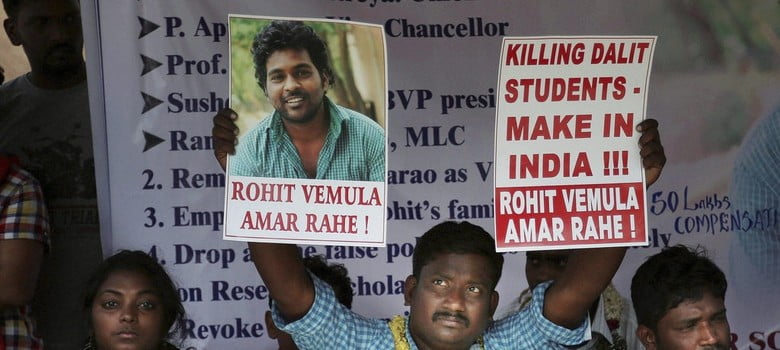By the third day, even the mundane started taking on meaning, or at least provoking questions. So it was with the sign that read “Regular Lunch” with a hand-drawn arrow pointing to a dining hall. Innocent no doubt, though occasion for a little head-scratching – what’s an “irregular lunch” then? But was there another way to read it: a subtle sign of discrimination perhaps? You folks of one type this way, you other folks over there?
No matter how far-fetched, in this climate, such trains of thought came easy.
It began with one of the first few people I met on the campus of the University of Hyderabad – G, a member of the staff. (Like some others, he wanted me to say no more to identify him than that much.) Otherwise genial and helpful, he turned serious as he himself brought up the protest that had shut down the campus. “These people, they are all Dalit goondas. What else can we expect from them?”
We discussed that a bit, but desultorily. What was there to say to someone who would so summarily dismiss an entire protest?
The story
Rohith Vemula’s suicide hangs over his sun-baked University like a cloud that won’t burst. His name, visage and lines from his eloquent suicide letter are everywhere. “Justice for Rohith” marks bus-shelters and hostel walls and road surfaces. (One stretch of road had “Resist Saffron Surge” in enormous letters). “Missing” posters feature the absent Vice-Chancellor Appa Rao Podile. Some embellish his image into a rodent-like caricature; others are placed, meaningfully, above a “Ladies Toilet” sign and a “Sports Shooting Range” board. Several students turned up at my writing workshop wearing gags as a statement of protest. Several more wrote and spoke – heartfelt, passionate – about Vemula, what this tragic episode had come to mean to them, their wish that they could have done more, understood more.
Like G, most people I spoke to were eager to recount the episode. They invariably started from months earlier when an ABVP leader posted some less-than-complimentary remarks about campus Dalits on Facebook. Thirty students from the Ambedkar Students’ Association, or ASA – including Vemula – visited him that night. By nobody’s telling was this a friendly pow-wow. But whether it was a shouting match or worse, events then took on a momentum of their own. They went something like this, though not necessarily in this order: the ABVP leader claimed to have been assaulted; he was admitted to a hospital; he (or his mother) complained to local Bharatiya Janata Party Member of Parliament Bandaru Dattatreya; Dattatreya wrote a letter to Minister of Human Resource Development Smriti Irani alleging that University of Hyderabad was a hotbed of “casteist” and “anti-national” sentiment; a university inquiry absolved the ASA students; Irani’s office wrote to the University five different times over two months asking what action it had taken against the ASA students; another university inquiry suspended five of them including Vemula; they protested by settling into tents on campus; Vemula took his own life on January 17; the protest then engulfed the entire University, shutting down classes for two weeks; various politicians, including Rahul Gandhi and Akbaruddin Owaisi, arrived on campus.
With some variation, addition and omission, everyone offered up essentially this story.
Divided campus
Yet to this outsider, it seems to have utterly divided the campus. If you agreed with the protests, there were those like G to brand you “lazy” at best and a “Dalit goonda” at worst. If you fretted at the shutdown of classes, there were those who would accuse you of being “elitist” and an “upper caste sympathiser”.
People on both “sides” told me about a team of professors who arrived at the protest site on January 21 to attempt a dialogue, only to be driven away with this chanted slogan: “Brahminical faculty go back”. One side saw this as reprehensible. But R and P (names withheld again), presumably on the other side, told me that these professors had “a record of being Brahminical”, and if the label fits …
If professors deserve that label, do protesters similarly deserve the “Dalit goonda” label?
And all through my few days there, three other currents flowed like a river in spate through the campus.
One, the feverish hand-wringing about the “politicisation” of the tragedy, referring to the arrival on campus of Gandhi and Owaisi and others. Yet somehow that earlier letter written by a politician named Dattatreya occasioned no such hand-wringing. What else was that but politicisation?
Two, the wrangles over Vemula’s caste that disturbed, for example, even some who wanted classes to resume. Rather than address the concerns this sad episode raises, there were strenuous attempts to suggest that Vemula was not a Dalit. That by itself tells a tale of how deeply rooted caste is in us all. As an off-campus Hyderabad friend, Harimohan Paruvu,wrote on his blog, “What does it make us, whom [Vemula] left behind?”
Three, the anguish of the “middle-grounder”, expressed eloquently in a short essay on Facebook by a faculty member, Anjali Lal Gupta. Was it no longer possible to consider nuance, to listen, to attempt dialogue? Where was the space for people who wanted those things – who believed they lived them – and yet were met with scorn for merely speaking about them? M, a student I met, actually wiped tears from her eyes as she spoke of how her good friends from just two weeks earlier now sat apart from her in their classes.
Speaking at the protest site on February 2, the thinker and writer Yogendra Yadav summed up the import of all this. The real impact of this wrenching upheaval on the University of Hyderabad campus, he said, would not be evident in a few days or weeks. Instead, it will be judged by what the campus is like in 20 years.
Indeed. What will we, whom Vemula left behind, be like in 20 years?
[“source-Scroll”]






 Photo Credit:
Photo Credit: